Drama Tuesday - Principles of story in drama
/Drama uses the Elements of Drama to tell stories. Story drives how we dynamically combine the Elements of Drama
Story in Drama is a way of making sense and meaning of experiences so that they can be shared and understood by others.
The Principles of Story include: Plot and sequencing of events; characters and people; setting; conflict and Language.
Within each these major categories there are specific aspects that can be linked to both story and drama.
Plot and sequence link to action and reaction; cause and effect; time and how it is manipulated; and, to the narrative arc of exposition, complication, rising tension, climax and resolution or denouement.
In stories, characters and people link to protagonist and antagonist; rounded and flat characters; dialogue revealing roles, relationships and motivations.
Setting links to a sense of place and time and to to mood and atmosphere.
Conflict relates to the use of tensions and suspense; the various ways of thinking about the conflicts person to person; character to Nature, Society and Circumstances; and also the inner conflict within a character.
Language is indispensable for story and drama; in story there is a focus on description, inner dialogue, symbol and the use of the author’s voice.
There are clear links between the Elements of Drama and the Principles of Story.
Role characters and relationships are linked to aspects of Characters and people found in stories.
Situation links to Plot and sequencing of stories as well as the setting.
There is the use of tension in both drama and story.
Drama uses aspects of language, ideas, meaning making and symbol.
The other Elements of Drama – Voice and Movement, Space and Time, Focus and Audience – are indirectly found in narrative stories.
In Drama we embody stories that narrative fiction tells through print or words alone.










